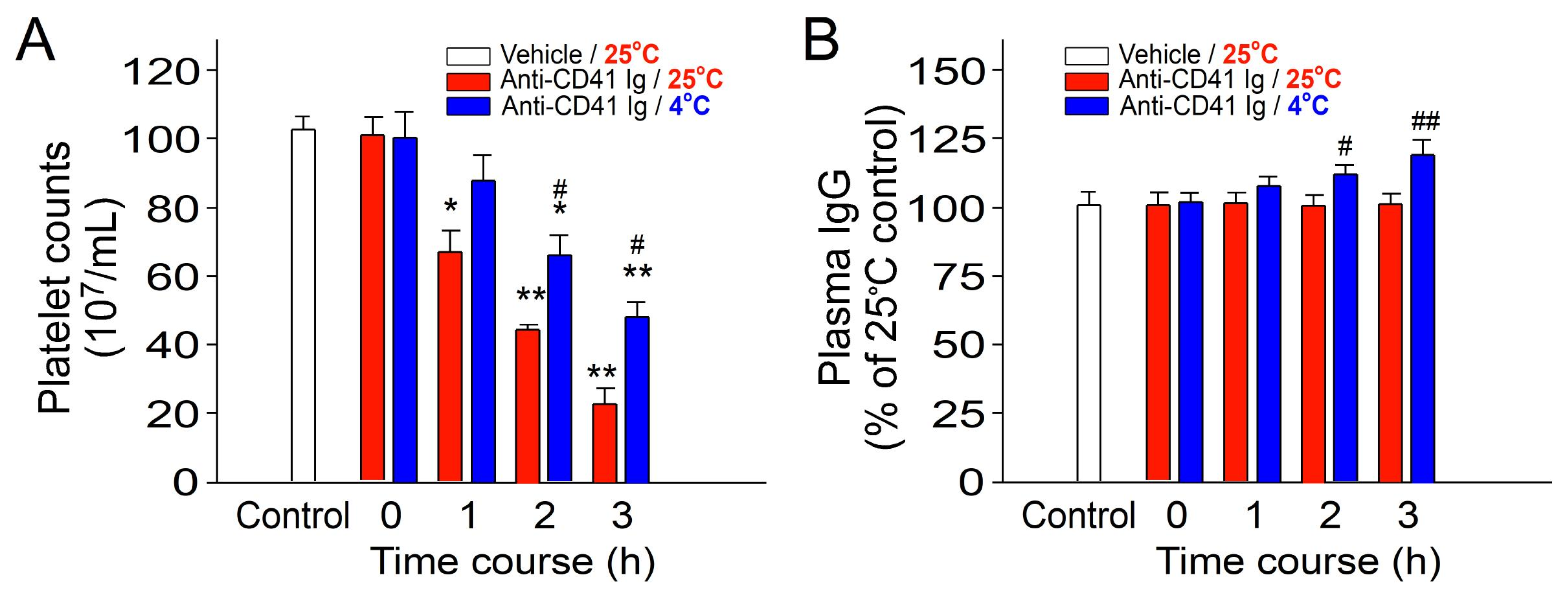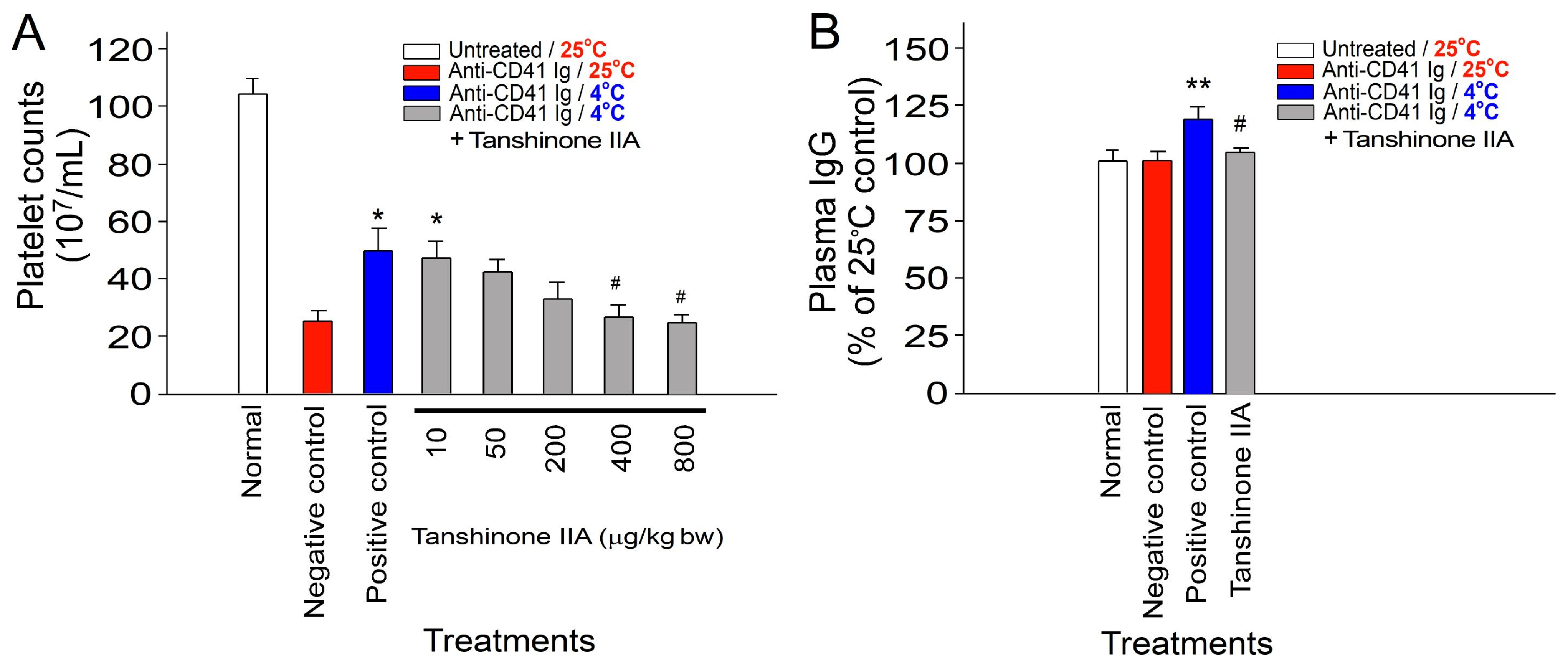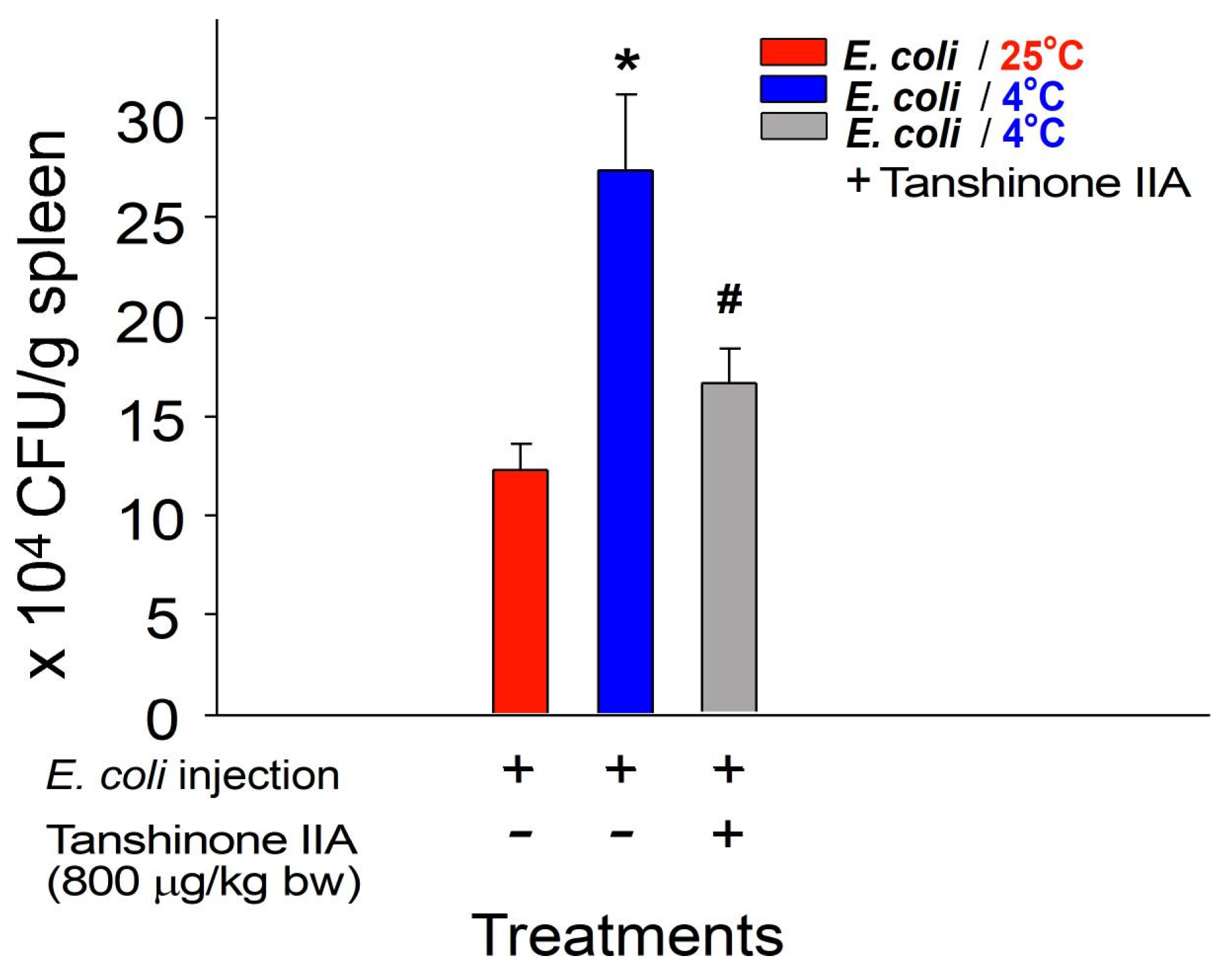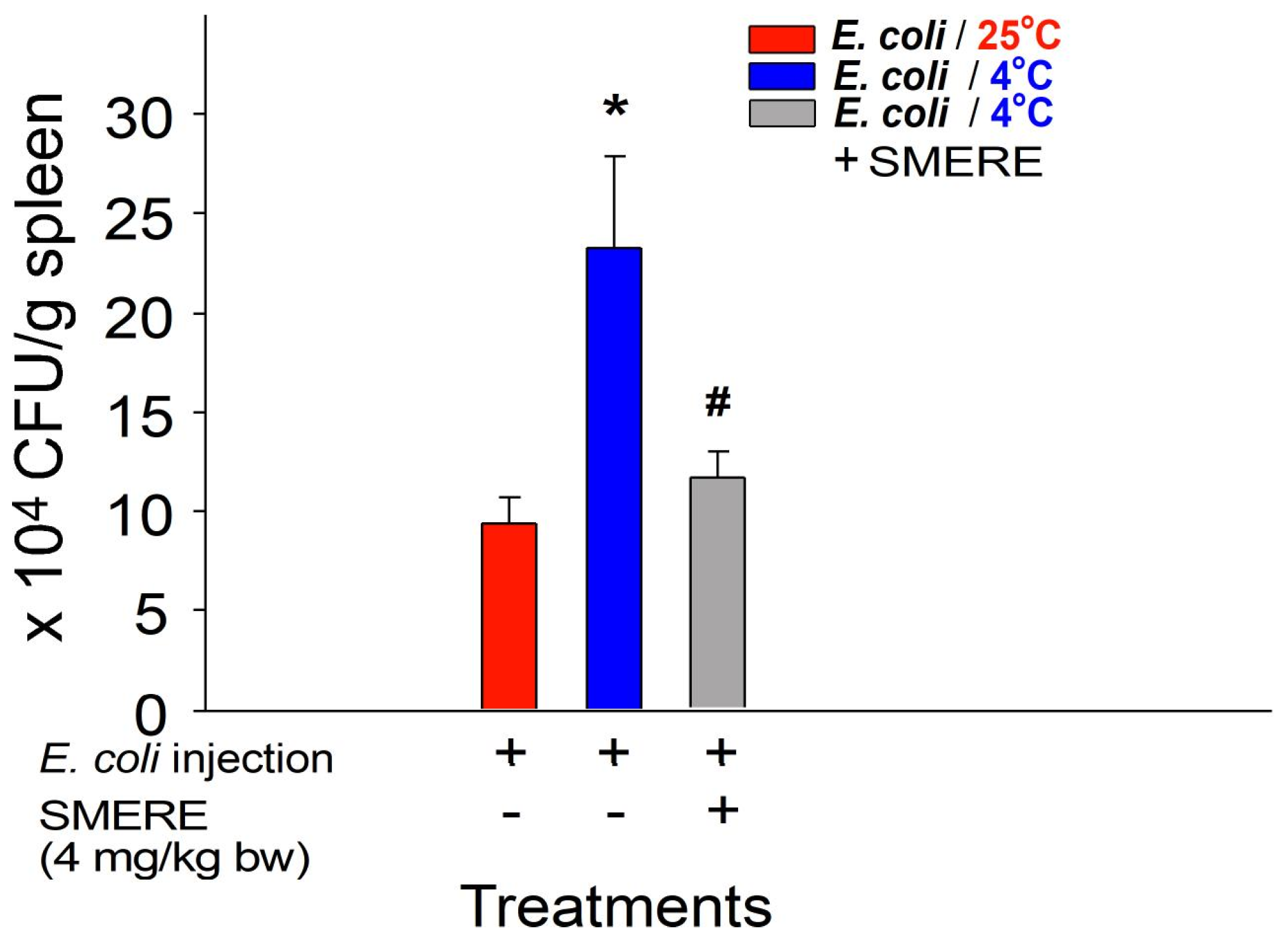Therapeutic Potential of Salvia miltiorrhiza Root Extract in Alleviating Cold-Induced Immunosuppression
Abstract
1. Introduction
2. Results
2.1. Cold-Induced Immunosuppression Revealed by Ameliorated Immune Thrombocytopenia and Increased Circulating IgG Levels in Mice
2.2. Reversal of Cold-Induced Immunosuppression in Mice through Treatment with a S. miltiorrhiza Root Component Tanshinone IIA
2.3. Reversal of Cold-Induced Immunosuppression through Treatment with SMERE in Mice
3. Discussion
4. Materials and Methods
4.1. Laboratory Mice
4.2. Measurements of Plasma IgG Levels in the Cold Exposure Mouse Model
4.3. Induction of Experimental Immune Thrombocytopenia (ITP) in the Cold Exposure Mouse Model
4.4. Analysis of Bacterial Clearance in the Cold Exposure Mouse Model
4.5. Tanshinone IIA, and S. miltiorrhiza Root Ethanolic Extract
4.6. Statistical Analyses
5. Conclusions
Author Contributions
Funding
Institutional Review Board Statement
Informed Consent Statement
Data Availability Statement
Acknowledgments
Conflicts of Interest
References
- Chan, H.; Huang, H.S.; Sun, D.S.; Lee, C.J.; Lien, T.S.; Chang, H.H. TRPM8 and RAAS-mediated hypertension is critical for cold-induced immunosuppression in mice. Oncotarget 2018, 9, 12781–12795. [Google Scholar] [CrossRef] [PubMed][Green Version]
- Buttke, T.M.; Yang, M.C.; Van Cleave, S.; Miller, N.W.; Clem, L.W. Correlation between low-temperature immunosuppression and the absence of unsaturated fatty acid synthesis in murine T cells. Comp. Biochem. Physiol. B 1991, 100, 269–276. [Google Scholar] [CrossRef] [PubMed]
- Huang, D.; Taha, M.S.; Nocera, A.L.; Workman, A.D.; Amiji, M.M.; Bleier, B.S. Cold exposure impairs extracellular vesicle swarm-mediated nasal antiviral immunity. J. Allergy Clin. Immunol. 2023, 151, 509–525.e508. [Google Scholar] [CrossRef]
- Persson, C. Plasma proteins defending infected, intact nasal mucosa. J. Allergy Clin. Immunol. 2023, 151, 1411–1412. [Google Scholar] [CrossRef]
- Brenner, I.K.; Castellani, J.W.; Gabaree, C.; Young, A.J.; Zamecnik, J.; Shephard, R.J.; Shek, P.N. Immune changes in humans during cold exposure: Effects of prior heating and exercise. J. Appl. Physiol. 1999, 87, 699–710. [Google Scholar] [CrossRef]
- Shephard, R.J.; Shek, P.N. Cold exposure and immune function. Can. J. Physiol. Pharmacol. 1998, 76, 828–836. [Google Scholar] [CrossRef] [PubMed]
- Vialard, F.; Olivier, M. Thermoneutrality and Immunity: How Does Cold Stress Affect Disease? Front. Immunol. 2020, 11, 588387. [Google Scholar] [CrossRef]
- Cao, L.; Hudson, C.A.; Lawrence, D.A. Immune changes during acute cold/restraint stress-induced inhibition of host resistance to Listeria. Toxicol. Sci. 2003, 74, 325–334. [Google Scholar] [CrossRef]
- Dropulic, L.K.; Lederman, H.M. Overview of Infections in the Immunocompromised Host. Microbiol. Spectr. 2016, 4. [Google Scholar] [CrossRef]
- Verheijden, R.J.; van Eijs, M.J.M.; May, A.M.; van Wijk, F.; Suijkerbuijk, K.P.M. Immunosuppression for immune-related adverse events during checkpoint inhibition: An intricate balance. NPJ Precis. Oncol. 2023, 7, 41. [Google Scholar] [CrossRef]
- Anders, H.J. Immune regulation of kidney disease in 2015: Updates on immunosuppression in kidney disease. Nat. Rev. Nephrol. 2016, 12, 65–66. [Google Scholar] [CrossRef] [PubMed]
- Handley, G.; Hand, J. Adverse Effects of Immunosuppression: Infections. Handb. Exp. Pharmacol. 2022, 272, 287–314. [Google Scholar] [CrossRef]
- Wolf, S.; Lauseker, M.; Schiergens, T.; Wirth, U.; Drefs, M.; Renz, B.; Ryll, M.; Bucher, J.; Werner, J.; Guba, M.; et al. Infections after kidney transplantation: A comparison of mTOR-Is and CNIs as basic immunosuppressants. A systematic review and meta-analysis. Transpl. Infect. Dis. 2020, 22, e13267. [Google Scholar] [CrossRef] [PubMed]
- Ponticelli, C.; Glassock, R.J. Prevention of complications from use of conventional immunosuppressants: A critical review. J. Nephrol. 2019, 32, 851–870. [Google Scholar] [CrossRef] [PubMed]
- Parlakpinar, H.; Gunata, M. Transplantation and immunosuppression: A review of novel transplant-related immunosuppressant drugs. Immunopharmacol. Immunotoxicol. 2021, 43, 651–665. [Google Scholar] [CrossRef]
- Sharma, A.; Jasrotia, S.; Kumar, A. Effects of Chemotherapy on the Immune System: Implications for Cancer Treatment and Patient Outcomes. Naunyn. Schmiedebergs. Arch. Pharmacol. 2024, 397, 2551–2566. [Google Scholar] [CrossRef]
- Kanterman, J.; Sade-Feldman, M.; Baniyash, M. New insights into chronic inflammation-induced immunosuppression. Semin. Cancer Biol. 2012, 22, 307–318. [Google Scholar] [CrossRef]
- Zhang, Z.J. Shang Han Lun: On Cold Damage, Translation & Commentaries, 1st ed.; Paradigm Publications: New York, NY, USA, 1999. [Google Scholar]
- Hippocrates. On Airs, Waters, and Places 370 BC. Available online: https://archive.org/stream/hippocrates-airs-waters-places-l-147/Hippocrates_Airs_Waters_Places_L147_djvu.txt (accessed on 27 August 2024).
- Eccles, R. Acute cooling of the body surface and the common cold. Rhinology 2002, 40, 109–114. [Google Scholar] [PubMed]
- Liu, C.M.; Lin, S.H.; Chen, Y.C.; Lin, K.C.; Wu, T.S.; King, C.C. Temperature drops and the onset of severe avian influenza A H5N1 virus outbreaks. PLoS ONE 2007, 2, e191. [Google Scholar] [CrossRef]
- Mourtzoukou, E.G.; Falagas, M.E. Exposure to cold and respiratory tract infections. Int. J. Tuberc. Lung Dis. 2007, 11, 938–943. [Google Scholar]
- Helman, C.G. “Feed a cold, starve a fever”—Folk models of infection in an English suburban community, and their relation to medical treatment. Cult. Med. Psychiatry 1978, 2, 107–137. [Google Scholar] [CrossRef] [PubMed]
- Nair, H.; Brooks, W.A.; Katz, M.; Roca, A.; Berkley, J.A.; Madhi, S.A.; Simmerman, J.M.; Gordon, A.; Sato, M.; Howie, S.; et al. Global burden of respiratory infections due to seasonal influenza in young children: A systematic review and meta-analysis. Lancet 2011, 378, 1917–1930. [Google Scholar] [CrossRef]
- Islam, A.; Munro, S.; Hassan, M.M.; Epstein, J.H.; Klaassen, M. The role of vaccination and environmental factors on outbreaks of high pathogenicity avian influenza H5N1 in Bangladesh. One Health 2023, 17, 100655. [Google Scholar] [CrossRef]
- Elsobky, Y.; El Afandi, G.; Abdalla, E.; Byomi, A.; Reddy, G. Possible ramifications of climate variability on HPAI-H5N1 outbreak occurrence: Case study from the Menoufia, Egypt. PLoS ONE 2020, 15, e0240442. [Google Scholar] [CrossRef]
- Matsuki, E.; Kawamoto, S.; Morikawa, Y.; Yahagi, N. The Impact of Cold Ambient Temperature in the Pattern of Influenza Virus Infection. Open Forum. Infect. Dis. 2023, 10, ofad039. [Google Scholar] [CrossRef] [PubMed]
- Shock, A.; Humphreys, D.; Nimmerjahn, F. Dissecting the mechanism of action of intravenous immunoglobulin in human autoimmune disease: Lessons from therapeutic modalities targeting Fcgamma receptors. J. Allergy Clin. Immunol. 2020, 146, 492–500. [Google Scholar] [CrossRef]
- Schwab, I.; Nimmerjahn, F. Intravenous immunoglobulin therapy: How does IgG modulate the immune system? Nat. Rev. Immunol. 2013, 13, 176–189. [Google Scholar] [CrossRef] [PubMed]
- Huang, H.S.; Sun, D.S.; Lien, T.S.; Chang, H.H. Dendritic cells modulate platelet activity in IVIg-mediated amelioration of ITP in mice. Blood 2010, 116, 5002–5009. [Google Scholar] [CrossRef][Green Version]
- Karnam, A.; Rambabu, N.; Das, M.; Bou-Jaoudeh, M.; Delignat, S.; Kasermann, F.; Lacroix-Desmazes, S.; Kaveri, S.V.; Bayry, J. Therapeutic normal IgG intravenous immunoglobulin activates Wnt-beta-catenin pathway in dendritic cells. Commun. Biol. 2020, 3, 96. [Google Scholar] [CrossRef] [PubMed]
- Tang, J.; Zhao, X. Research Progress on Regulation of Immune Response by Tanshinones and Salvianolic Acids of Danshen (Salvia miltiorrhiza Bunge). Molecules 2024, 29, 1201. [Google Scholar] [CrossRef]
- Guo, R.; Li, L.; Su, J.; Li, S.; Duncan, S.E.; Liu, Z.; Fan, G. Pharmacological Activity and Mechanism of Tanshinone IIA in Related Diseases. Drug Des. Devel. Ther. 2020, 14, 4735–4748. [Google Scholar] [CrossRef] [PubMed]
- Chan, P.; Liu, I.M.; Li, Y.X.; Yu, W.J.; Cheng, J.T. Antihypertension Induced by Tanshinone IIA Isolated from the Roots of Salvia miltiorrhiza. Evid.-Based Complement. Altern. Med. eCAM 2011, 2011, 392627. [Google Scholar] [CrossRef] [PubMed]
- Xu, J.; Zhang, C.; Shi, X.; Li, J.; Liu, M.; Jiang, W.; Fang, Z. Efficacy and Safety of Sodium Tanshinone IIA Sulfonate Injection on Hypertensive Nephropathy: A Systematic Review and Meta-Analysis. Front. Pharmacol. 2019, 10, 1542. [Google Scholar] [CrossRef] [PubMed]
- Hu, G.; Song, Y.; Ke, S.; Cao, H.; Zhang, C.; Deng, G.; Yang, F.; Zhou, S.; Liu, P.; Guo, X.; et al. Tanshinone IIA protects against pulmonary arterial hypertension in broilers. Poult. Sci. 2017, 96, 1132–1138. [Google Scholar] [CrossRef]
- Wong, M.S.; Chen, C.W.; Hsieh, C.C.; Hung, S.C.; Sun, D.S.; Chang, H.H. Antibacterial property of Ag nanoparticle-impregnated N-doped titania films under visible light. Sci. Rep. 2015, 5, 11978. [Google Scholar] [CrossRef]
- Wong, M.S.; Sun, M.T.; Sun, D.S.; Chang, H.H. Visible-Light-Responsive Antibacterial Property of Boron-Doped Titania Films. Catalysts 2020, 10, 10111349. [Google Scholar] [CrossRef]
- Chang, H.H.; Sun, D.S. Method for Preventing and/or Treating a Stress-Induced Disease. European Patent Application No. 21175048.4, 20 May 2021. [Google Scholar]
- Chang, H.H.; Sun, D.S. Method for Preventing and/or Treating a Stress-Induced Disease. Taiwan Patent No. I750705, 21 December 2021. [Google Scholar]
- Shahrajabian, M.H.; Sun, W.; Cheng, Q. Clinical aspects and health benefits of ginger (Zingiber officinale) in both traditional Chinese medicine and modern industry. Acta Agric. Scand. Sect. B Soil Plant Sci. 2019, 69, 545–556. [Google Scholar] [CrossRef]
- Saxena, B.; Saxena, U. Anti-stress effects of cinnamon (Cassia zelynicum) bark extract in cold restraint stress rat model. Int. J. Res. Dev. Pharm. Life Sci. 2012, 1, 28–31. [Google Scholar]
- Sugimoto, K.; Takeuchi, H.; Nakagawa, K.; Matsuoka, Y. Hyperthermic Effect of Ginger (Zingiber officinale) Extract-Containing Beverage on Peripheral Skin Surface Temperature in Women. Evid.-Based Complement. Altern. Med. eCAM 2018, 2018, 3207623. [Google Scholar] [CrossRef]
- Xiang, L.; Bo, X.; Xin, L.; Jiang, X.W.; Lu, H.Y.; Xu, Z.H.; Yue, Y.; Qiong, W.; Dong, Y.; Zhang, Y.S.; et al. Network pharmacology-based research uncovers cold resistance and thermogenesis mechanism of Cinnamomum cassia. Fitoterapia 2021, 149, 104824. [Google Scholar] [CrossRef]
- Daniels, C.C.; Isaacs, Z.; Finelli, R.; Leisegang, K. The efficacy of Zingiber officinale on dyslipidaemia, blood pressure, and inflammation as cardiovascular risk factors: A systematic review. Clin. Nutr. ESPEN 2022, 51, 72–82. [Google Scholar] [CrossRef] [PubMed]
- Shirzad, F.; Morovatdar, N.; Rezaee, R.; Tsarouhas, K.; Abdollahi Moghadam, A. Cinnamon effects on blood pressure and metabolic profile: A double-blind, randomized, placebo-controlled trial in patients with stage 1 hypertension. Avicenna. J. Phytomed. 2021, 11, 91–100. [Google Scholar] [PubMed]
- Abdelrahman, I.A.; Ahad, A.; Raish, M.; Bin Jardan, Y.A.; Alam, M.A.; Al-Jenoobi, F.I. Cinnamon modulates the pharmacodynamic & pharmacokinetic of amlodipine in hypertensive rats. Saudi Pharm. J. 2023, 31, 101737. [Google Scholar] [CrossRef] [PubMed]
- Wan, X.; Wu, W.; Zang, Z.; Li, K.; Naeem, A.; Zhu, Y.; Chen, L.; Zhong, L.; Zhu, W.; Guan, Y. Investigation of the potential curative effects of Gui-Zhi-Jia-Ge-Gen decoction on wind-cold type of common cold using multidimensional analysis. J. Ethnopharmacol. 2022, 298, 115662. [Google Scholar] [CrossRef]
- Liu, J.; Feng, W.; Peng, C. A Song of Ice and Fire: Cold and Hot Properties of Traditional Chinese Medicines. Front. Pharmacol. 2020, 11, 598744. [Google Scholar] [CrossRef]
- Wang, S.D.; Lin, L.J.; Chen, C.L.; Lee, S.C.; Lin, C.C.; Wang, J.Y.; Kao, S.T. Xiao-Qing-Long-Tang attenuates allergic airway inflammation and remodeling in repetitive Dermatogoides pteronyssinus challenged chronic asthmatic mice model. J. Ethnopharmacol. 2012, 142, 531–538. [Google Scholar] [CrossRef]
- Kao, S.T.; Wang, S.D.; Wang, J.Y.; Yu, C.K.; Lei, H.Y. The effect of Chinese herbal medicine, xiao-qing-long tang (XQLT), on allergen-induced bronchial inflammation in mite-sensitized mice. Allergy 2000, 55, 1127–1133. [Google Scholar] [CrossRef]
- Byun, J.S.; Yang, S.Y.; Jeong, I.C.; Hong, K.E.; Kang, W.; Yeo, Y.; Park, Y.C. Effects of So-cheong-ryong-tang and Yeon-gyo-pae-dok-san on the common cold: Randomized, double blind, placebo controlled trial. J. Ethnopharmacol. 2011, 133, 642–646. [Google Scholar] [CrossRef]
- Wu, Y.; Xu, S.; Tian, X.Y. The Effect of Salvianolic Acid on Vascular Protection and Possible Mechanisms. Oxid. Med. Cell. Longev. 2020, 2020, 5472096. [Google Scholar] [CrossRef]
- Wu, Q.; Yuan, X.; Li, B.; Han, R.; Zhang, H.; Xiu, R. Salvianolic Acid Alleviated Blood-Brain Barrier Permeability in Spontaneously Hypertensive Rats by Inhibiting Apoptosis in Pericytes via P53 and the Ras/Raf/MEK/ERK Pathway. Drug. Des. Devel. Ther. 2020, 14, 1523–1534. [Google Scholar] [CrossRef]
- Chen, K.; Guan, Y.; Wu, S.; Quan, D.; Yang, D.; Wu, H.; Lv, L.; Zhang, G. Salvianolic acid D: A potent molecule that protects against heart failure induced by hypertension via Ras signalling pathway and PI3K/Akt signalling pathway. Heliyon 2023, 9, e12337. [Google Scholar] [CrossRef] [PubMed]
- Chen, Y.C.; Yuan, T.Y.; Zhang, H.F.; Wang, D.S.; Yan, Y.; Niu, Z.R.; Lin, Y.H.; Fang, L.H.; Du, G.H. Salvianolic acid A attenuates vascular remodeling in a pulmonary arterial hypertension rat model. Acta Pharmacol. Sin. 2016, 37, 772–782. [Google Scholar] [CrossRef] [PubMed]
- Ling, W.C.; Liu, J.; Lau, C.W.; Murugan, D.D.; Mustafa, M.R.; Huang, Y. Treatment with salvianolic acid B restores endothelial function in angiotensin II-induced hypertensive mice. Biochem. Pharmacol. 2017, 136, 76–85. [Google Scholar] [CrossRef]
- Zhang, Z.; Chen, B.; Yuan, L.; Niu, C. Acute cold stress improved the transcription of pro-inflammatory cytokines of Chinese soft-shelled turtle against Aeromonas hydrophila. Dev. Comp. Immunol. 2015, 49, 127–137. [Google Scholar] [CrossRef] [PubMed]
- Ren, J.; Fu, L.; Nile, S.H.; Zhang, J.; Kai, G. Salvia miltiorrhiza in Treating Cardiovascular Diseases: A Review on Its Pharmacological and Clinical Applications. Front. Pharmacol. 2019, 10, 753. [Google Scholar] [CrossRef]
- Li, Z.M.; Xu, S.W.; Liu, P.Q. Salvia miltiorrhizaBurge (Danshen): A golden herbal medicine in cardiovascular therapeutics. Acta Pharmacol. Sin. 2018, 39, 802–824. [Google Scholar] [CrossRef] [PubMed]
- Ng, C.F.; Koon, C.M.; Cheung, D.W.; Lam, M.Y.; Leung, P.C.; Lau, C.B.; Fung, K.P. The anti-hypertensive effect of Danshen (Salvia miltiorrhiza) and Gegen (Pueraria lobata) formula in rats and its underlying mechanisms of vasorelaxation. J. Ethnopharmacol. 2011, 137, 1366–1372. [Google Scholar] [CrossRef]
- Hu, F.; Koon, C.M.; Chan, J.Y.; Lau, K.M.; Kwan, Y.W.; Fung, K.P. Involvements of calcium channel and potassium channel in Danshen and Gegen decoction induced vasodilation in porcine coronary LAD artery. Phytomedicine 2012, 19, 1051–1058. [Google Scholar] [CrossRef]
- Huang, N.; Huang, J.; Feng, F.; Ba, Z.; Li, Y.; Luo, Y. Tanshinone IotaIotaA-Incubated Mesenchymal Stem Cells Inhibit Lipopolysaccharide-Induced Inflammation of N9 Cells through TREM2 Signaling Pathway. Stem. Cells Int. 2022, 2022, 9977610. [Google Scholar] [CrossRef]
- Jang, S.I.; Jeong, S.I.; Kim, K.J.; Kim, H.J.; Yu, H.H.; Park, R.; Kim, H.M.; You, Y.O. Tanshinone IIA from Salvia miltiorrhiza inhibits inducible nitric oxide synthase expression and production of TNF-alpha, IL-1beta and IL-6 in activated RAW 264.7 cells. Planta Med. 2003, 69, 1057–1059. [Google Scholar] [CrossRef]
- Liu, Q.Y.; Zhuang, Y.; Song, X.R.; Niu, Q.; Sun, Q.S.; Li, X.N.; Li, N.; Liu, B.L.; Huang, F.; Qiu, Z.X. Tanshinone IIA prevents LPS-induced inflammatory responses in mice via inactivation of succinate dehydrogenase in macrophages. Acta. Pharmacol. Sin. 2021, 42, 987–997. [Google Scholar] [CrossRef] [PubMed]
- Yang, C.; Mu, Y.; Li, S.; Zhang, Y.; Liu, X.; Li, J. Tanshinone IIA: A Chinese herbal ingredient for the treatment of atherosclerosis. Front. Pharmacol. 2023, 14, 1321880. [Google Scholar] [CrossRef] [PubMed]
- Chen, Z.; Xu, H. Anti-Inflammatory and Immunomodulatory Mechanism of Tanshinone IIA for Atherosclerosis. Evid. Based Complement Altern. Med. eCAM 2014, 2014, 267976. [Google Scholar] [CrossRef] [PubMed]
- Chen, Z.; Gao, X.; Jiao, Y.; Qiu, Y.; Wang, A.; Yu, M.; Che, F.; Li, S.; Liu, J.; Li, J.; et al. Tanshinone IIA Exerts Anti-Inflammatory and Immune-Regulating Effects on Vulnerable Atherosclerotic Plaque Partially via the TLR4/MyD88/NF-kappaB Signal Pathway. Front. Pharmacol. 2019, 10, 850. [Google Scholar] [CrossRef]
- Tang, J.; Zhou, S.; Zhou, F.; Wen, X. Inhibitory effect of tanshinone IIA on inflammatory response in rheumatoid arthritis through regulating beta-arrestin 2. Exp. Ther. Med. 2019, 17, 3299–3306. [Google Scholar] [CrossRef]
- Chen, Z.; Feng, H.; Peng, C.; Zhang, Z.; Yuan, Q.; Gao, H.; Tang, S.; Xie, C. Renoprotective Effects of Tanshinone IIA: A Literature Review. Molecules 2023, 28, 1990. [Google Scholar] [CrossRef]
- Fu, K.; Feng, C.; Shao, L.; Mei, L.; Cao, R. Tanshinone IIA exhibits anti-inflammatory and antioxidative effects in LPS-stimulated bovine endometrial epithelial cells by activating the Nrf2 signaling pathway. Res. Vet. Sci. 2021, 136, 220–226. [Google Scholar] [CrossRef]
- Chen, W.; Li, X.; Guo, S.; Song, N.; Wang, J.; Jia, L.; Zhu, A. Tanshinone IIA harmonizes the crosstalk of autophagy and polarization in macrophages via miR-375/KLF4 pathway to attenuate atherosclerosis. Int. Immunopharmacol. 2019, 70, 486–497. [Google Scholar] [CrossRef]
- Li, D.; Yang, Z.; Gao, S.; Zhang, H.; Fan, G. Tanshinone IIA ameliorates myocardial ischemia/reperfusion injury in rats by regulation of NLRP3 inflammasome activation and Th17 cells differentiation. Acta. Cir. Bras. 2022, 37, e370701. [Google Scholar] [CrossRef]
- Gong, Y.; Liu, Y.C.; Ding, X.L.; Fu, Y.; Cui, L.J.; Yan, Y.P. Tanshinone IIA Ameliorates CNS Autoimmunity by Promoting the Differentiation of Regulatory T Cells. Neurotherapeutics 2020, 17, 690–703. [Google Scholar] [CrossRef]
- Jang, S.I.; Kim, H.J.; Kim, Y.J.; Jeong, S.I.; You, Y.O. Tanshinone IIA inhibits LPS-induced NF-kappaB activation in RAW 264.7 cells: Possible involvement of the NIK-IKK, ERK1/2, p38 and JNK pathways. Eur. J. Pharmacol. 2006, 542, 1–7. [Google Scholar] [CrossRef]
- Zhang, Z.; Xu, D.; Yu, W.; Qiu, J.; Xu, C.; He, C.; Xu, X.; Yin, J. Tanshinone IIA Inhibits Tissue Factor Expression Induced by Thrombin in Human Umbilical Vein Endothelial Cells via PAR-1 and p38 MAPK Signaling Pathway. Acta. Haematol. 2022, 145, 517–528. [Google Scholar] [CrossRef] [PubMed]
- Jin, H.; Peng, X.; He, Y.; Ruganzu, J.B.; Yang, W. Tanshinone IIA suppresses lipopolysaccharide-induced neuroinflammatory responses through NF-kappaB/MAPKs signaling pathways in human U87 astrocytoma cells. Brain Res. Bull. 2020, 164, 136–145. [Google Scholar] [CrossRef] [PubMed]
- Han, D.; Wu, X.; Liu, L.; Shu, W.; Huang, Z. Sodium tanshinone IIA sulfonate protects ARPE-19 cells against oxidative stress by inhibiting autophagy and apoptosis. Sci. Rep. 2018, 8, 15137. [Google Scholar] [CrossRef]
- Chen, R.; Chen, W.; Huang, X.; Rui, Q. Tanshinone IIA attenuates heart failure via inhibiting oxidative stress in myocardial infarction rats. Mol. Med. Rep. 2021, 23, 404. [Google Scholar] [CrossRef]
- Guo, J.; Hu, H.; Chen, Z.; Xu, J.; Nie, J.; Lu, J.; Ma, L.; Ji, H.; Yuan, J.; Xu, B. Cold Exposure Induces Intestinal Barrier Damage and Endoplasmic Reticulum Stress in the Colon via the SIRT1/Nrf2 Signaling Pathway. Front. Physiol. 2022, 13, 822348. [Google Scholar] [CrossRef] [PubMed]
- Guo, J.; Nie, J.; Chen, Z.; Wang, X.; Hu, H.; Xu, J.; Lu, J.; Ma, L.; Ji, H.; Yuan, J.; et al. Cold exposure-induced endoplasmic reticulum stress regulates autophagy through the SIRT2/FoxO1 signaling pathway. J. Cell Physiol. 2022, 237, 3960–3970. [Google Scholar] [CrossRef]
- Cai, J.; Zhao, C.; Du, Y.; Huang, Y.; Zhao, Q. Amentoflavone ameliorates cold stress-induced inflammation in lung by suppression of C3/BCR/NF-kappaB pathways. BMC Immunol. 2019, 20, 49. [Google Scholar] [CrossRef]
- Li, C.C.; Munalisa, R.; Lee, H.Y.; Lien, T.S.; Chan, H.; Hung, S.C.; Sun, D.S.; Cheng, C.F.; Chang, H.H. Restraint Stress-Induced Immunosuppression Is Associated with Concurrent Macrophage Pyroptosis Cell Death in Mice. Int. J. Mol. Sci. 2023, 24, 12877. [Google Scholar] [CrossRef]
- Lien, T.S.; Sun, D.S.; Hung, S.C.; Wu, W.S.; Chang, H.H. Dengue Virus Envelope Protein Domain III Induces Nlrp3 Inflammasome-Dependent NETosis-Mediated Inflammation in Mice. Front. Immunol. 2021, 12, 618577. [Google Scholar] [CrossRef]
- Lien, T.S.; Sun, D.S.; Wu, C.Y.; Chang, H.H. Exposure to Dengue Envelope Protein Domain III Induces Nlrp3 Inflammasome-Dependent Endothelial Dysfunction and Hemorrhage in Mice. Front. Immunol. 2021, 12, 617251. [Google Scholar] [CrossRef] [PubMed]
- Hung, S.C.; Ke, L.C.; Lien, T.S.; Huang, H.S.; Sun, D.S.; Cheng, C.L.; Chang, H.H. Nanodiamond-Induced Thrombocytopenia in Mice Involve P-Selectin-Dependent Nlrp3 Inflammasome-Mediated Platelet Aggregation, Pyroptosis and Apoptosis. Front. Immunol. 2022, 13, 806686. [Google Scholar] [CrossRef] [PubMed]
- Tuttle, A.R.; Trahan, N.D.; Son, M.S. Growth and Maintenance of Escherichia coli Laboratory Strains. Curr. Protoc. 2021, 1, e20. [Google Scholar] [CrossRef] [PubMed]






Disclaimer/Publisher’s Note: The statements, opinions and data contained in all publications are solely those of the individual author(s) and contributor(s) and not of MDPI and/or the editor(s). MDPI and/or the editor(s) disclaim responsibility for any injury to people or property resulting from any ideas, methods, instructions or products referred to in the content. |
© 2024 by the authors. Licensee MDPI, Basel, Switzerland. This article is an open access article distributed under the terms and conditions of the Creative Commons Attribution (CC BY) license (https://creativecommons.org/licenses/by/4.0/).
Share and Cite
Li, C.-C.; Liu, S.-L.; Lien, T.-S.; Sun, D.-S.; Cheng, C.-F.; Hamid, H.; Chen, H.-P.; Ho, T.-J.; Lin, I.-H.; Wu, W.-S.; et al. Therapeutic Potential of Salvia miltiorrhiza Root Extract in Alleviating Cold-Induced Immunosuppression. Int. J. Mol. Sci. 2024, 25, 9432. https://doi.org/10.3390/ijms25179432
Li C-C, Liu S-L, Lien T-S, Sun D-S, Cheng C-F, Hamid H, Chen H-P, Ho T-J, Lin I-H, Wu W-S, et al. Therapeutic Potential of Salvia miltiorrhiza Root Extract in Alleviating Cold-Induced Immunosuppression. International Journal of Molecular Sciences. 2024; 25(17):9432. https://doi.org/10.3390/ijms25179432
Chicago/Turabian StyleLi, Chi-Cheng, Song-Lin Liu, Te-Sheng Lien, Der-Shan Sun, Ching-Feng Cheng, Hussana Hamid, Hao-Ping Chen, Tsung-Jung Ho, I-Hsin Lin, Wen-Sheng Wu, and et al. 2024. "Therapeutic Potential of Salvia miltiorrhiza Root Extract in Alleviating Cold-Induced Immunosuppression" International Journal of Molecular Sciences 25, no. 17: 9432. https://doi.org/10.3390/ijms25179432
APA StyleLi, C.-C., Liu, S.-L., Lien, T.-S., Sun, D.-S., Cheng, C.-F., Hamid, H., Chen, H.-P., Ho, T.-J., Lin, I.-H., Wu, W.-S., Hu, C.-T., Tsai, K.-W., & Chang, H.-H. (2024). Therapeutic Potential of Salvia miltiorrhiza Root Extract in Alleviating Cold-Induced Immunosuppression. International Journal of Molecular Sciences, 25(17), 9432. https://doi.org/10.3390/ijms25179432








